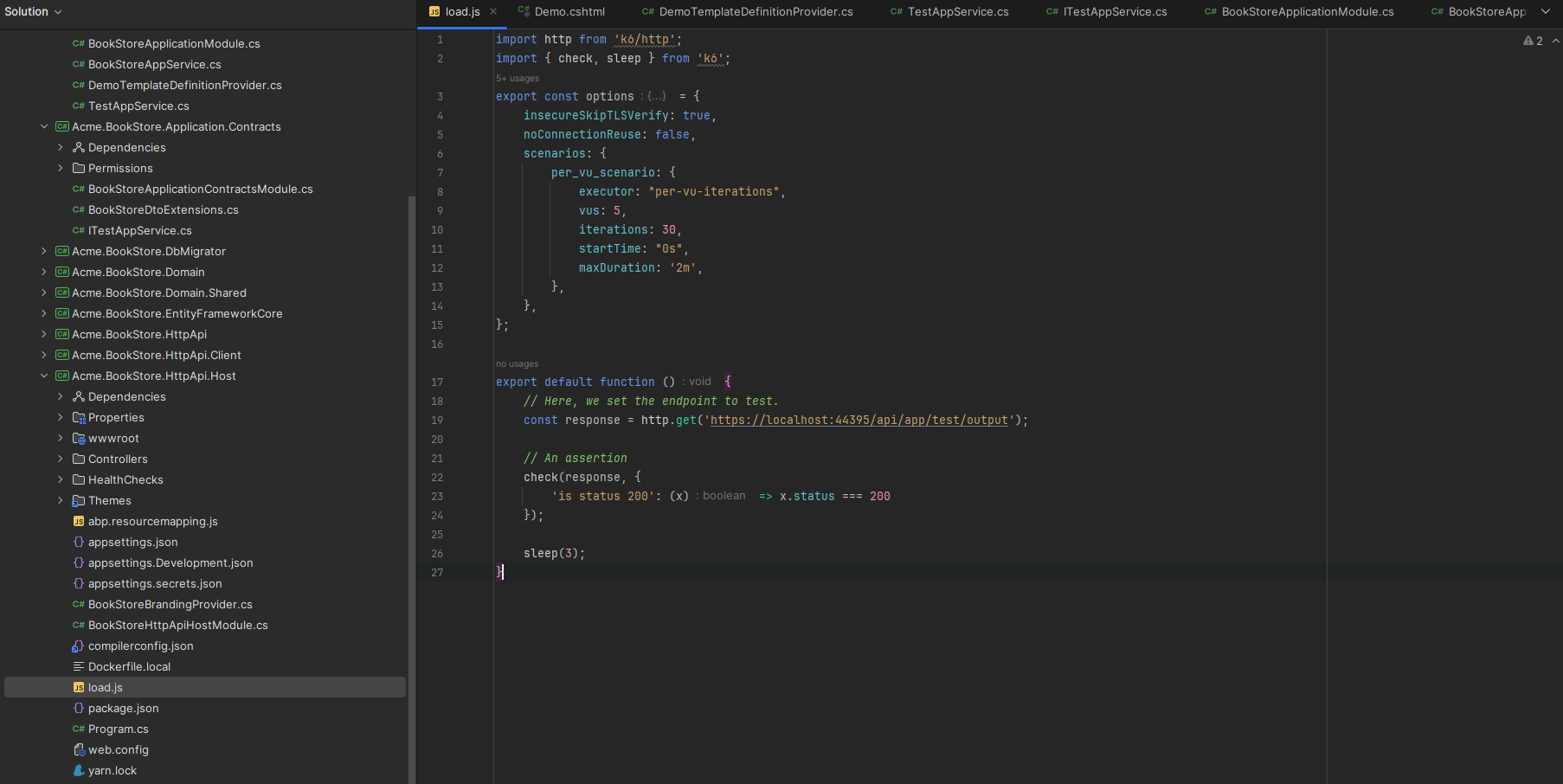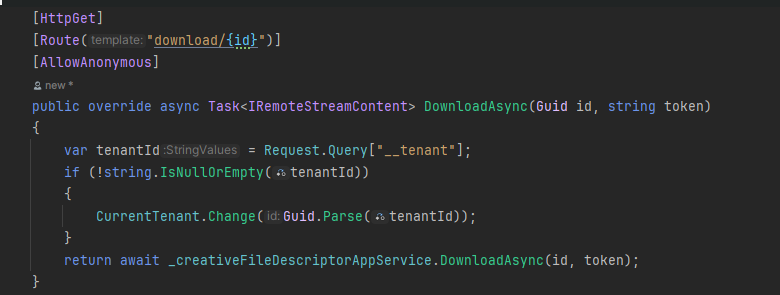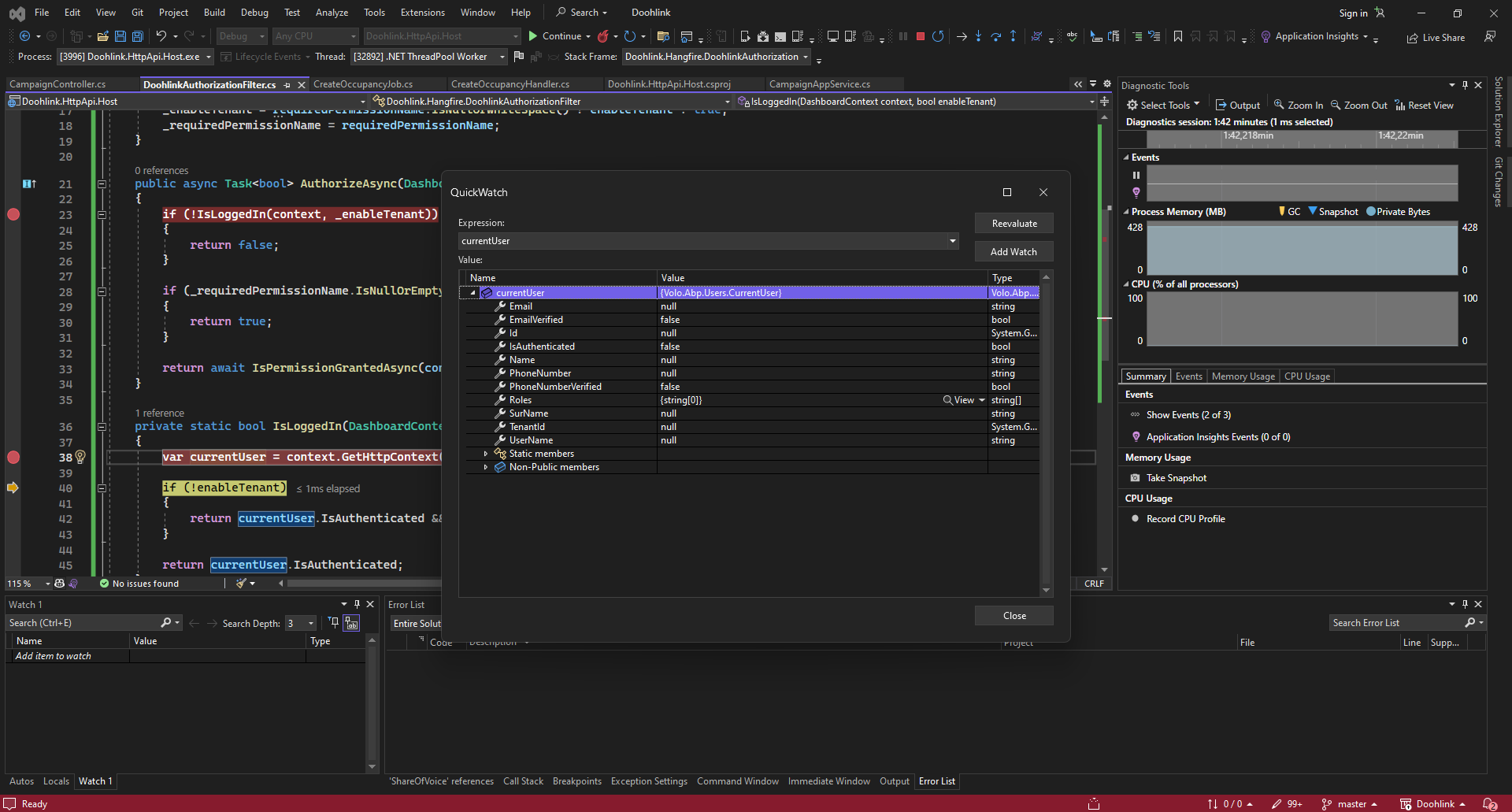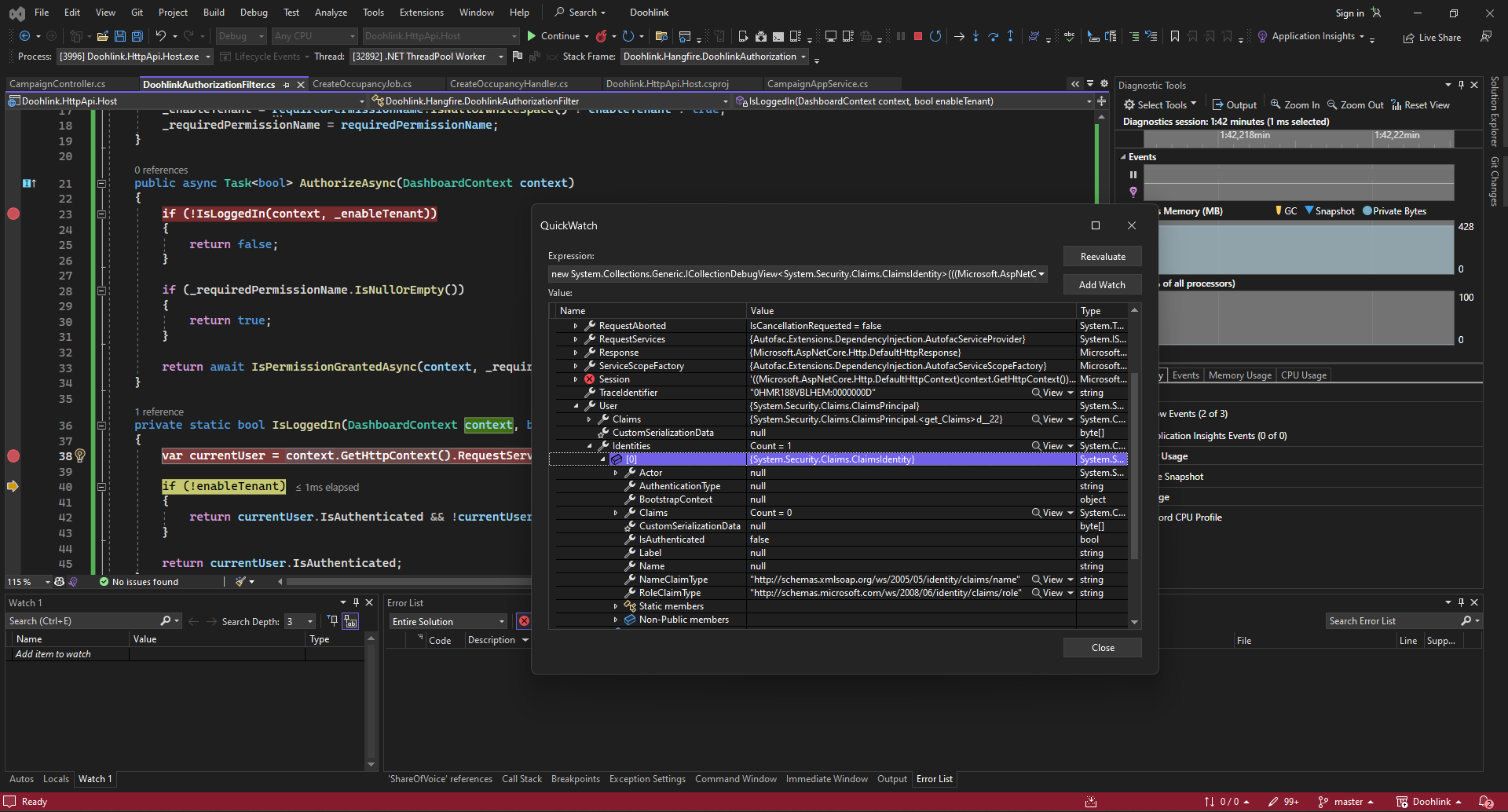"cangunaydin" की गतिविधियाँ
- ABP Framework version: v7.4.0
- UI Type: Angular
- Database System: EF Core ( PostgreSQL)
- Tiered (for MVC) or Auth Server Separated (for Angular): yes
Hello,
I am using Volo.Payment module and i customized it little bit, only payment provider we use is stripe at the time.
So what i want to achieve is, when the user update the plan from stripe dashboard ( modify the payment plan, changing the productid or priceid not only date) I want to be able to modify the necessary things in db. Like finding that tenant and switching to different edition.
As i see from PaymentModule
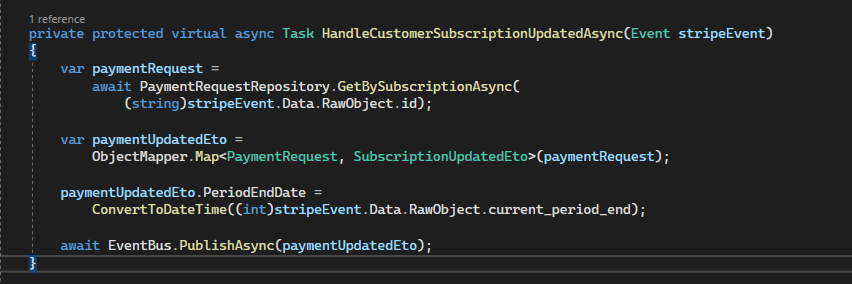
it only gets the value "current_period_end" from the webhook call payload. So PaymentUpdatedEto is not holding those values. and since the method is "private protected virtual" i can not override the method so i can pass extra parameters with the event. How can i solve the problem? should i modify the PaymentRequestAppService instead?
public override async Task<bool> HandleWebhookAsync(string paymentGateway, string payload, Dictionary<string, string> headers)
{
if (paymentGateway=="stripe")
{
//call my service and return
}
await PaymentGatewayResolver.Resolve(paymentGateway).HandleWebhookAsync(payload, headers);
return true;
}
for the next version, is it possible to change private protected methods like "HandleCustomerSubscriptionUpdatedAsync" and "HandleCustomerSubscriptionDeletedAsync" to protected only so it could be overridden.
- ABP Framework version: v7.4.0
- UI Type: Angular
- Database System: EF Core ( PostgreSQL)
- Tiered (for MVC) or Auth Server Separated (for Angular): yes
Hello I want to serve different databases for different tenants and I know abp supports that and have a very good documentation about it. In my case i have a little bit different scenario.
I am building a server that multiple iot devices will hit the server and they are gonna be registered to host database (they do not belong to any tenant at that moment). Then the host tenant administrator needs to assign the devices to one of the tenants in the system from user interface.
So when it is assigned, i need to check if tenant has a separate db connection and according to that i will change the ICurrentTenant and insert a new data to tenant db. Then delete the data from host db. That is my plan. Sth like this.
public async Task ApproveForSeparateDbAsync(ApproveScreenForSeparateDbDto input)
{
var newScreens = new List<Screen>();
var screens = await _screenRepository.GetListByIdsAsync(input.ScreenIds);
using (CurrentTenant.Change(input.TenantId))
{
foreach (var screen in screens)
{
var newScreen = new Screen(GuidGenerator.Create(),
screen.Name,
screen.MacAddress,
screen.DeviceType,
screen.DeviceTypeVersion,
screen.ModelNumber,
screen.ApplicationVersion,
screen.IpAddress,
screen.Port,
screen.CurrentClock,
input.TenantId);
newScreen.Approve(input.TenantId,isSeparateDb:true);
newScreens.Add(newScreen);
}
await _screenRepository.InsertManyAsync(newScreens);
}
foreach (var screen in screens)
{
await _screenManager.DeleteWithEventAsync(screen);
}
}
Screen is a FullAuditedAggregateRoot with IMultiTenant interface.
here is screen constructor.
public Screen(
Guid id,
string name,
string macAddress,
string deviceType,
int deviceTypeVersion,
string modelNumber,
string applicationVersion,
string ipAddress,
int port,
DateTime currentClock,
Guid? tenantId = null) : base(id)
{
Check.NotNullOrWhiteSpace(macAddress, nameof(macAddress));
Check.NotNullOrWhiteSpace(deviceType, nameof(deviceType));
Check.NotNullOrWhiteSpace(modelNumber, nameof(modelNumber));
Check.Positive(deviceTypeVersion, nameof(deviceTypeVersion));
TenantId = tenantId;
UpdateName(name);
MacAddress = macAddress;
DeviceType = deviceType;
DeviceTypeVersion = deviceTypeVersion;
ModelNumber = modelNumber;
UpdateApplicationVersion(applicationVersion);
CurrentClock = currentClock;
IpAddress = ipAddress;
Port = port;
var openingHours = OpeningHoursHelper.GetDefault().Select(o => new OpeningHoursEto()
{
Id = o.Id,
Day = o.Day,
StartTime = o.StartTime,
EndTime = o.EndTime
}).ToList();
AddLocalEvent(new ScreenCreatedEto()
{
Id = id,
Name = name,
MacAddress = macAddress,
TenantId = TenantId,
OpeningHours = openingHours
});
}
you can see that over here i am trying to trigger an event so listeners can do the necessary work. when unitofwork completed it doesn't trigger any event. Weird part is if i do the same by injecting ILocalEventBus to appservice. It triggers the event. and you can see the local events on CurrentUnitOfWork.LocalEventHandlers.
Also if i change
using (CurrentTenant.Change(input.TenantId))
to
using (CurrentTenant.Change(null))
it also triggers the events. I suppose this is some kind of bug or sth i don't know when the current tenant has different Database.
- ABP Framework version: v7.4.0
- UI Type: Angular
- Database System: EF Core (PostgreSQL)
- Tiered (for MVC) or Auth Server Separated (for Angular): yes
Hello I am trying to find out bottlenecks inside my app with stress testing. I am preparing the server to handle more than 5000 device requests. It is going to be 1 get / post request in every 5 secs for each device. Each device is sending a soap xml format when they do post and when they do get, they are getting a response as xml from the server. To serve xml to device, I use Volo.Abp.TextTemplating.Scriban
I prepare my controllers to connect to database less frequently so i do not create bottleneck in database. To do that i use Microsoft Orleans. Holding the data in memory then saving it to database in every 5 mins since it is not a critical data that comes from the device. However for some critical data sometimes I need to persist the data, this is happening at first request from each device. I use k6 for stress test. I prepared a test for 3000 devices. I also make a setup for pgbouncer in front of postgresql for connection pooling. Things are okay until 2000 devices after this number I am getting this exception.
2023-10-16 22:03:31.077 +02:00 [ERR] The operation was canceled. System.OperationCanceledException: The operation was canceled. at System.Threading.CancellationToken.ThrowOperationCanceledException() at System.Threading.SemaphoreSlim.WaitUntilCountOrTimeoutAsync(TaskNode asyncWaiter, Int32 millisecondsTimeout, CancellationToken cancellationToken) at Volo.Abp.Threading.SemaphoreSlimExtensions.LockAsync(SemaphoreSlim semaphoreSlim, CancellationToken cancellationToken) at Volo.Abp.Caching.DistributedCache
2.GetOrAddAsync(TCacheKey key, Func1 factory, Func1 optionsFactory, Nullable1 hideErrors, Boolean considerUow, CancellationToken token) at Volo.Abp.TextTemplateManagement.TextTemplates.DatabaseTemplateContentContributor.GetOrNullAsync(TemplateContentContributorContext context) at Volo.Abp.TextTemplating.TemplateContentProvider.GetContentOrNullAsync(ITemplateContentContributor[] contributors, TemplateContentContributorContext context) at Volo.Abp.TextTemplating.TemplateContentProvider.GetContentOrNullAsync(TemplateDefinition templateDefinition, String cultureName, Boolean tryDefaults, Boolean useCurrentCultureIfCultureNameIsNull) at Volo.Abp.TextTemplating.TemplateRenderingEngineBase.GetContentOrNullAsync(TemplateDefinition templateDefinition) at Volo.Abp.TextTemplating.Scriban.ScribanTemplateRenderingEngine.RenderSingleTemplateAsync(TemplateDefinition templateDefinition, Dictionary2 globalContext, Object model) at Volo.Abp.TextTemplating.Scriban.ScribanTemplateRenderingEngine.RenderInternalAsync(String templateName, Dictionary2 globalContext, Object model) at Volo.Abp.TextTemplating.Scriban.ScribanTemplateRenderingEngine.RenderAsync(String templateName, Object model, String cultureName, Dictionary2 globalContext) at Volo.Abp.TextTemplating.AbpTemplateRenderer.RenderAsync(String templateName, Object model, String cultureName, Dictionary2 globalContext) at Doohlink.MagicInfo.Envelopes.Renderers.EnvelopeRenderingService1.RenderAsync(EnvelopeHeader header, TModel body) in C:\Development\Projects\Examples\Doohlink\aspnet-core\modules\Doohlink.MagicInfo\src\Doohlink.MagicInfo.Domain\Envelopes\Renderers\EnvelopeRenderingService.cs:line 30 at Doohlink.MagicInfo.Handlers.CommandHandler.HandleAsync(Envelope1 envelope) in C:\Development\Projects\Examples\Doohlink\aspnet-core\modules\Doohlink.MagicInfo\src\Doohlink.MagicInfo.Application\Handlers\CommandHandler.cs:line 90 at Doohlink.MagicInfo.Handlers.EnvelopeHandler.HandlePostAsync(String body) in C:\Development\Projects\Examples\Doohlink\aspnet-core\modules\Doohlink.MagicInfo\src\Doohlink.MagicInfo.Application\Handlers\EnvelopeHandler.cs:line 62
and after the stress test finished, the application can not connect to redis anymore. i need to flush redis. Also you can see that inside the logs.
2023-10-16 22:42:47.163 +02:00 [WRN] The message timed out in the backlog attempting to send because no connection became available, command=HMGET, timeout: 5000, outbound: 0KiB, inbound: 0KiB, inst: 0, qu: 89, qs: 0, aw: True, bw: CheckingForTimeoutComplete, rs: ReadAsync, ws: Idle, in: 0, in-pipe: 0, out-pipe: 0, last-in: 0, cur-in: 0, sync-ops: 833, async-ops: 49078, serverEndpoint: localhost:6379, conn-sec: 1484.52, aoc: 1, mc: 1/1/0, mgr: 10 of 10 available, clientName: DESKTOP-NHAEDKT(SE.Redis-v2.6.122.38350), IOCP: (Busy=0,Free=1000,Min=1,Max=1000), WORKER: (Busy=47,Free=32720,Min=6,Max=32767), POOL: (Threads=52,QueuedItems=441,CompletedItems=2340351,Timers=7635), v: 2.6.122.38350 (Please take a look at this article for some common client-side issues that can cause timeouts: https://stackexchange.github.io/StackExchange.Redis/Timeouts) StackExchange.Redis.RedisTimeoutException: The message timed out in the backlog attempting to send because no connection became available, command=HMGET, timeout: 5000, outbound: 0KiB, inbound: 0KiB, inst: 0, qu: 89, qs: 0, aw: True, bw: CheckingForTimeoutComplete, rs: ReadAsync, ws: Idle, in: 0, in-pipe: 0, out-pipe: 0, last-in: 0, cur-in: 0, sync-ops: 833, async-ops: 49078, serverEndpoint: localhost:6379, conn-sec: 1484.52, aoc: 1, mc: 1/1/0, mgr: 10 of 10 available, clientName: DESKTOP-NHAEDKT(SE.Redis-v2.6.122.38350), IOCP: (Busy=0,Free=1000,Min=1,Max=1000), WORKER: (Busy=47,Free=32720,Min=6,Max=32767), POOL: (Threads=52,QueuedItems=441,CompletedItems=2340351,Timers=7635), v: 2.6.122.38350 (Please take a look at this article for some common client-side issues that can cause timeouts: https://stackexchange.github.io/StackExchange.Redis/Timeouts) at StackExchange.Redis.ConnectionMultiplexer.ExecuteSyncImpl[T](Message message, ResultProcessor
1 processor, ServerEndPoint server, T defaultValue) in /_/src/StackExchange.Redis/ConnectionMultiplexer.cs:line 2099 at StackExchange.Redis.RedisDatabase.HashGet(RedisKey key, RedisValue[] hashFields, CommandFlags flags) in /_/src/StackExchange.Redis/RedisDatabase.cs:line 405 at Microsoft.Extensions.Caching.StackExchangeRedis.RedisExtensions.HashMemberGet(IDatabase cache, String key, String[] members) at Microsoft.Extensions.Caching.StackExchangeRedis.RedisCache.GetAndRefresh(String key, Boolean getData) at Volo.Abp.Caching.DistributedCache2.Get(TCacheKey key, Nullable`1 hideErrors, Boolean considerUow) 2023-10-16 22:42:47.163 +02:00 [WRN] ---------- Exception Data ---------- Redis-Message = HMGET c:Volo.Abp.LanguageManagement.Texts,k:Adzup:AbpExceptionHandling_en Redis-Timeout = 5000 Redis-Write-State = Idle Redis-Read-State = ReadAsync Redis-OutboundDeltaKB = 0KiB Redis-InboundDeltaKB = 0KiB Redis-OpsSinceLastHeartbeat = 0 Redis-Queue-Awaiting-Write = 89 Redis-Queue-Awaiting-Response = 0 Redis-Active-Writer = True Redis-Backlog-Writer = CheckingForTimeoutComplete Redis-Inbound-Bytes = 0 Redis-Inbound-Pipe-Bytes = 0 Redis-Outbound-Pipe-Bytes = 0 Redis-Last-Result-Bytes = 0 Redis-Inbound-Buffer-Bytes = 0 Redis-Sync-Ops = 833 Redis-Async-Ops = 49078 Redis-Server-Endpoint = localhost:6379 Redis-Server-Connected-Seconds = 1484.52 Redis-Abort-On-Connect = 1 Redis-Multiplexer-Connects = 1/1/0 Redis-Manager = 10 of 10 available Redis-Client-Name = DESKTOP-NHAEDKT(SE.Redis-v2.6.122.38350) Redis-ThreadPool-IO-Completion = (Busy=0,Free=1000,Min=1,Max=1000) Redis-ThreadPool-Workers = (Busy=47,Free=32720,Min=6,Max=32767) Redis-ThreadPool-Items = (Threads=52,QueuedItems=441,CompletedItems=2340351,Timers=7635) Redis-Busy-Workers = 47 Redis-Version = 2.6.122.38350 redis-command = HMGET c:Volo.Abp.LanguageManagement.Texts,k:Adzup:AbpExceptionHandling_en request-sent-status = WaitingInBacklog redis-server = localhost:6379
So couple of questions, - I understand from the exception that it is trying to get the template text from DatabaseTemplateContentContributor, at Volo.Abp.TextTemplateManagement.TextTemplates.DatabaseTemplateContentContributor.GetOrNullAsync(TemplateContentContributorContext context) I assume this is coming from Text Template Management Module (https://docs.abp.io/en/commercial/latest/modules/text-template-management#text-template-management-module) and since this is the last contributor, it is the first to try.
Since my text templates doesn't use any localization is it possible to use VirtualFileTemplateContentContributor instead? Of course I can add another ITemplateContentContributor. I just wonder if there is any other way to avoid trying the last contributor and only use VirtualFileTemplateContentContributor, since I don't want the code to go to redis cache or database at all. All I need is to get the template from virtual file system and replace it with the model.
- Also I wonder what is happening in this setup, Is the bottleneck happening from the redis cache or from the database connection? At first thought, I assume it is sth going on with Redis Cache, Cause if the templates are cached, it won't go to database after some time for the same template. But strange thing over here is if i increase the connection pool size in database, I can increase the concurrent users that the server handles. With 150 max connections and max pool size of 150 i can handle 2000 users, if i increase the pool size to 250 then the server can handle 3000 users with the same test. So it seems database connection pool has a role over here, but I am not expecting for the code to create a connection with database. Why it is happening? Can it be a bug when it tries to get the template from the cache? so it goes to database instead?
By the way I disabled auditlogging all over the application with this configuration. any help would be appreciated.
Configure<AbpAuditingOptions>(options =>
{
options.IsEnabled = false; //Disables the auditing system
});
- ABP Framework version: v7.4.0
- UI Type: No Ui
- Database System: EF Core (SQL Server, Oracle, MySQL, PostgreSQL, etc..)
- Tiered (for MVC) or Auth Server Separated (for Angular): no
Hello, I think razor text templating have a memory leak. And i suppose it is sth. with caching. To produce the problem here are the steps, I can also send a sample app for this.
- create a new app with abp cli.
abp new Acme.BookStore -u none -csf - then add Volo.Abp.TextTemplating.Razor module with cli. I added this inside application module but you can add it wherever you want.
abp add-package Volo.Abp.TextTemplating.Razor - Then create a model for the template I have added a model that takes a list. here it is.
public class Command
{
public bool ReportIndicate { get; set; }
public string CommandId { get; set; }
public string MoCmd { get; set; }
public MoSequence MoSequence { get; set; }
public Command()
{
}
public Command(bool reportIndicate, string commandId, string moCmd, MoSequence moSequence)
{
Check.NotNullOrWhiteSpace(commandId, nameof(commandId));
Check.NotNullOrWhiteSpace(moCmd, nameof(moCmd));
Check.NotNull(moSequence, nameof(moSequence));
ReportIndicate = reportIndicate;
CommandId = commandId;
MoCmd = moCmd;
MoSequence = moSequence;
}
}
public class MoSequence
{
public List<Mo> MoList { get; set; }
public MoSequence()
{
MoList = new List<Mo>();
}
public void AddMo(string moPath, string moValue)
{
MoList.Add(new Mo(moPath, moValue));
}
public void AddMo(string moPath)
{
MoList.Add(new Mo(moPath));
}
}
public class Mo
{
public string MoPath { get; set; }
public string MoValue { get; set; }
public Mo()
{
}
public Mo(string moPath)
{
MoPath = moPath;
}
public Mo(string moPath, string moValue)
{
MoPath = moPath;
MoValue = moValue;
}
}
- Now create a template for the command model. here you can find it.Add it as an embedded resource
@inherits Volo.Abp.TextTemplating.Razor.RazorTemplatePageBase<Acme.BookStore.Models.Command>
<srm:COMMAND>
<srm:REPORT_INDICATE>@(Model.ReportIndicate ? "true" : "false")</srm:REPORT_INDICATE>
<srm:COMMAND_ID>@Model.CommandId</srm:COMMAND_ID>
<srm:MO_CMD>@Model.MoCmd</srm:MO_CMD>
<srm:MO_SEQUENCE>
@foreach (var item in Model.MoSequence.MoList)
{
<srm:MO>
<srm:MO_PATH>@item.MoPath</srm:MO_PATH>
@if (item.MoValue != null)
{
<srm:MO_VALUE>@item.MoValue</srm:MO_VALUE>
}
else
{
<srm:MO_VALUE />
}
</srm:MO>
}
</srm:MO_SEQUENCE>
</srm:COMMAND>
- Create a TemplateDefinitionProvider.
public class DemoTemplateDefinitionProvider : TemplateDefinitionProvider
{
public override void Define(ITemplateDefinitionContext context)
{
context.Add(
new TemplateDefinition("Demo") //template name: "Demo"
.WithRazorEngine()
.WithVirtualFilePath(
"/Template/Demo.cshtml", //template content path
isInlineLocalized: true
)
);
}
}
- Add Configuration to your module
public override void ConfigureServices(ServiceConfigurationContext context)
{
Configure<AbpAutoMapperOptions>(options =>
{
options.AddMaps<BookStoreApplicationModule>();
});
Configure<AbpRazorTemplateCSharpCompilerOptions>(options =>
{
options.References.Add(MetadataReference.CreateFromFile(typeof(BookStoreApplicationModule).Assembly.Location));
});
Configure<AbpVirtualFileSystemOptions>(options =>
{
options.FileSets.AddEmbedded<BookStoreApplicationModule>("Acme.BookStore");
});
}
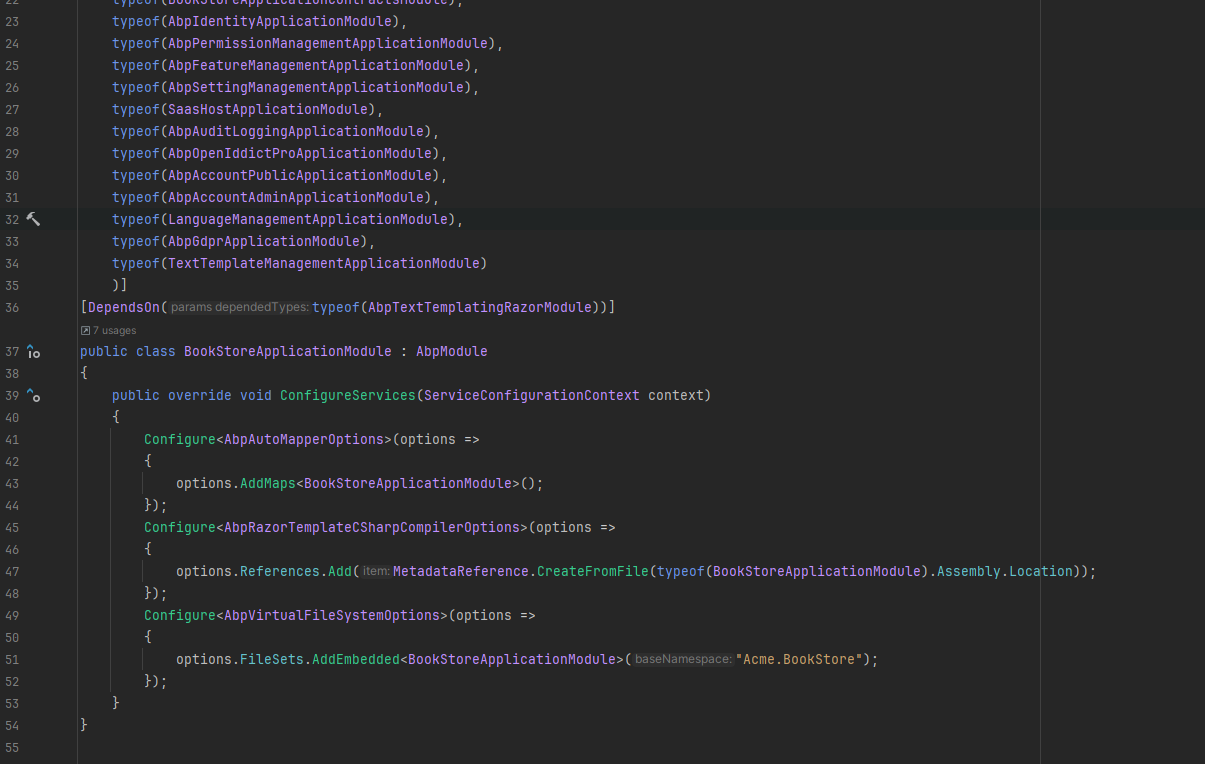 7) Create an appservice that will return the output.
7) Create an appservice that will return the output.
public class TestAppService : BookStoreAppService, ITestAppService
{
private readonly ITemplateRenderer _templateRenderer;
public TestAppService(ITemplateRenderer templateRenderer)
{
_templateRenderer = templateRenderer;
}
public async Task<string> GetOutput()
{
var moSequence = new MoSequence();
moSequence.AddMo(".MO.MONITOR_OPERATION.BOOTSTRAP.DEV_CODE", "105");
moSequence.AddMo(".MO.MONITOR_OPERATION.BOOTSTRAP.DEV_TYPE", "SPLAYER" + Random.Shared.Next().ToString());
moSequence.AddMo(".MO.MONITOR_OPERATION.BOOTSTRAP.DEV_MDNM", "QB13R");
var command = new Command(false,
"31470ade5bc2fd42-60c7af5-4725-8703-33dd729f63cea7aa5e4fbc0e",
".MO.MONITOR_OPERATION.BOOTSTRAP",
moSequence);
var result = await _templateRenderer.RenderAsync(
"Demo", //the template name
command
);
return result;
}
}
- Now you should be able to hit the endpoint. and it should return sth similar like this.
<srm:COMMAND>
<srm:REPORT_INDICATE>false</srm:REPORT_INDICATE>
<srm:COMMAND_ID>31470ade5bc2fd42-60c7af5-4725-8703-33dd729f63cea7aa5e4fbc0e</srm:COMMAND_ID>
<srm:MO_CMD>.MO.MONITOR_OPERATION.BOOTSTRAP</srm:MO_CMD>
<srm:MO_SEQUENCE>
<srm:MO>
<srm:MO_PATH>.MO.MONITOR_OPERATION.BOOTSTRAP.DEV_CODE</srm:MO_PATH>
<srm:MO_VALUE>105</srm:MO_VALUE>
</srm:MO>
<srm:MO>
<srm:MO_PATH>.MO.MONITOR_OPERATION.BOOTSTRAP.DEV_TYPE</srm:MO_PATH>
<srm:MO_VALUE>SPLAYER737483572</srm:MO_VALUE>
</srm:MO>
<srm:MO>
<srm:MO_PATH>.MO.MONITOR_OPERATION.BOOTSTRAP.DEV_MDNM</srm:MO_PATH>
<srm:MO_VALUE>QB13R</srm:MO_VALUE>
</srm:MO>
</srm:MO_SEQUENCE>
</srm:COMMAND>
- Now you need to call this endpoint with some frequency so you can see what is going on in memory. I have used dotMemory and k6 for it. here is my k6 .js file
import http from 'k6/http';
import { check, sleep } from 'k6';
export const options = {
insecureSkipTLSVerify: true,
noConnectionReuse: false,
scenarios: {
per_vu_scenario: {
executor: "per-vu-iterations",
vus: 5,
iterations: 30,
startTime: "0s",
maxDuration: '2m',
},
},
};
export default function () {
// Here, we set the endpoint to test.
const response = http.get('https://localhost:44395/api/app/test/output');
// An assertion
check(response, {
'is status 200': (x) => x.status === 200
});
sleep(3);
}
- if you run this js file from command line tool.
k6 run load.js
and check the memory spike in dotmemory you will see sth similar like this.
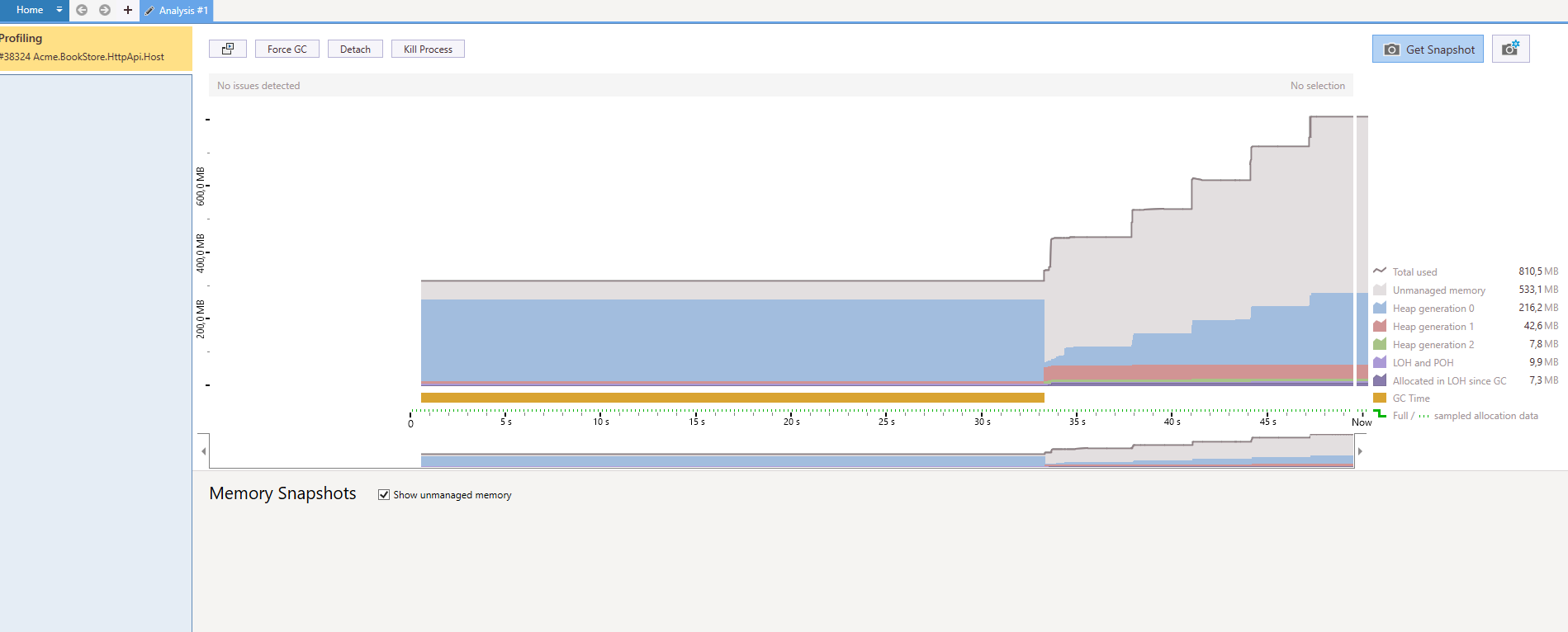
I analyze this with dotnet-dump and dotmemory. It has lots of free memory in unmanaged memory heap. mostly strings. I didn't check the source code. It could be sth wrong from caching so it caches the same thing in every request, but not sure, didn't deep dive into it.
If i switch to Volo.Abp.TextTemplating.Scriban, this doesn't happen and you can see the memory steady, no spikes. I switch to scriban and change all my templates with it. Hope i could clarify the problem if you need a sample app i can send it if you give an email address.
- ABP Framework version: v7.4.0
- UI Type: Angular
- Database System: EF Core (SQL Server, Oracle, MySQL, PostgreSQL, etc..)
Hello, I recently upgraded my abp version from 7.3.2 to 7.4.0, I don't know if this is related with upgrade, maybe this wasn't working fine before.
In angular part of the gdpr module, when i look at the source code, it checks the cookie consent, if it is true it doesn't show the accept cookie bar as I understand.
 here is the code for checking the cookie, here cookie key is '.AspNet.Consent'
here is the code for checking the cookie, here cookie key is '.AspNet.Consent'
protected checkCookieConsent() {
const hasCookieConsent =
decodeURIComponent(this.document.cookie)
.split(' ')
.indexOf(this.cookieKey + '=true') > -1;
if (hasCookieConsent) {
this.showCookieConsent = false;
}
}
When i look at my cookies on chrome,I can see that it is true.

when i debug this, i can see that array from the code decodeURIComponent(this.document.cookie.split(' ') has an item like

here you can see indexOf shouldn't be .indexOf(this.cookieKey + '=true') but it should be .indexOf(this.cookieKey + '=true;') to make it work (';' semicolon at the end). I use chrome by the way. Maybe it works with other browsers, i didn't test it with others. Is there any trick that I can do to fix it fast?
- ABP Framework version: v7.4.0
- UI Type: Angular
- Database System: EF Core (SQL Server, Oracle, MySQL, PostgreSQL, etc..)
- Tiered (for MVC) or Auth Server Separated (for Angular): yes
Hello I recently upgraded to Abp v7.4.0, I am using file management module with abp, I customize it according to my needs and it was working fine. Now i have a problem with file download. I think there is a bug related with it. Since i customize it i couldn't be sure but I didn't override download part before, so it is likely from the new version.
Anyway here is the problem. For download to work first angular is doing a backend call to get a token. Then doing get request by using javascript window.open here is the file management module angular code.
downloadFile(file: FileInfo) {
return this.fileDescriptorService.getDownloadToken(file.id).pipe(
tap((res) => {
window.open(
`${this.apiUrl}/api/file-management/file-descriptor/download/${file.id}?token=${res.token}`,
'_self'
);
})
);
}
"this.fileDescriptorService.getDownloadToken" call is an authenticated but file-descriptor/download call is anonymous call.
On the backend side, when IDistributedCache is used it sets the token for the current tenant. so it normalizes the cache key. here is the code for it.

public virtual async Task<DownloadTokenResultDto> GetDownloadTokenAsync(Guid id)
{
var token = Guid.NewGuid().ToString();
await DownloadTokenCache.SetAsync(
token,
new FileDownloadTokenCacheItem { FileDescriptorId = id },
new DistributedCacheEntryOptions
{
AbsoluteExpirationRelativeToNow = TimeSpan.FromSeconds(60)
});
return new DownloadTokenResultDto
{
Token = token
};
}
here the current tenant id is set. So the problem is when you do the second call to /api/file-management/file-descriptor/download/ endpoint with window.open since it is anonymous and token is not set it doesn't get the current tenant id. here is the code for it.
[AllowAnonymous]
public virtual async Task<IRemoteStreamContent> DownloadAsync(Guid id, string token)
{
var downloadToken = await DownloadTokenCache.GetAsync(token);
if (downloadToken == null || downloadToken.FileDescriptorId != id)
{
throw new AbpAuthorizationException("Invalid download token: " + token);
}
FileDescriptor fileDescriptor;
using (DataFilter.Disable<IMultiTenant>())
{
fileDescriptor = await FileDescriptorRepository.GetAsync(id);
}
var stream = await BlobContainer.GetAsync(id.ToString());
return new RemoteStreamContent(stream, fileDescriptor?.Name);
}
here you get authorization exception since cache key is not normalized over here. even if i override and change the current tenant id to null, it gets the token but this time BlobContainer can not find the file since this file belongs to tenant. What i came up with is to send tenantId from user interface as a query string and override FileDescriptorController like this.
also i override the angular part and inject the new service as a download service. sth like
@Injectable()
export class CreativeDownloadService {
apiName = 'FileManagement';
get apiUrl() {
return this.environment.getApiUrl(this.apiName);
}
constructor(
private restService: RestService,
private fileDescriptorService: FileDescriptorService,
private environment: EnvironmentService,
private configStateService: ConfigStateService
) {}
downloadFile(file: FileInfo) {
const currentUser = this.configStateService.getOne("currentUser");
return this.fileDescriptorService.getDownloadToken(file.id).pipe(
tap((res) => {
window.open(
`${this.apiUrl}/api/file-management/file-descriptor/download/${file.id}?token=${res.token}&__tenant=${currentUser?.tenantId}`,
'_self'
);
})
);
}
}
I don't know how this was working before. I wonder if new version changed sth, by the way i use redis cache.
Also sth I didn't understand is according to docs
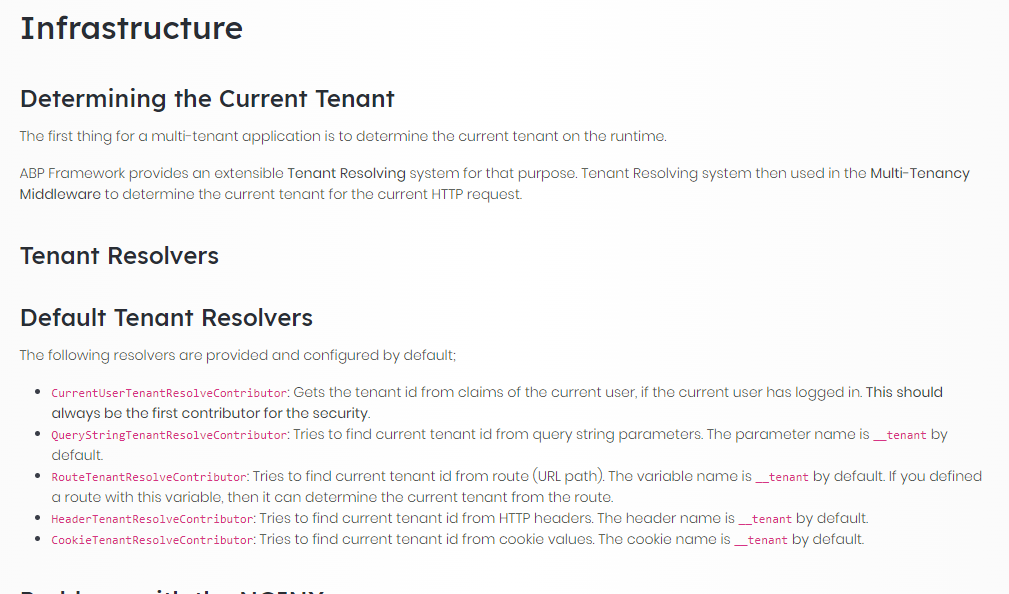
giving query string __tenant should set CurrentTenant but it doesn't do so. Is this related with [AllowAnonymous] attribute? Thanks for the help and waiting for your reply.
- ABP Framework version: v7.1.0
- UI type: Angular
- DB provider: EF Core
- Tiered (MVC) or Identity Server Separated (Angular): yes
Hello, I am trying to implement hangfire to my project. I managed to do that, the only problem that i have is with hangfire dashboard. If i do not use authentication for my hangfire dashboard it works fine. And i can access it. But when i have enabled the filter, i can not access the page. In HttpContext i can not see the user claims, so it return unauthenticated inside AbpHangfireAuthorizationFilter.
I logged in with admin rights and when i call a method from swagger endpoint i can see that claims are there for user and CurrentUser.IsAuthenticated property returns true. I couldn't understand why current user is unauthenticated (or claims are not in the context) when AbpHangfireAuthorizationFilter is triggered. any tips about it?
here is the onApplicationInitialization
public override void OnApplicationInitialization(ApplicationInitializationContext context)
{
var app = context.GetApplicationBuilder();
var env = context.GetEnvironment();
if (env.IsDevelopment())
{
app.UseDeveloperExceptionPage();
}
app.UseAbpRequestLocalization();
app.UseStaticFiles();
app.UseAbpSecurityHeaders();
app.UseRouting();
app.UseCors();
app.UseAuthentication();
if (MultiTenancyConsts.IsEnabled)
{
app.UseMultiTenancy();
}
app.UseAuthorization();
app.UseSwagger();
app.UseAbpSwaggerUI(options =>
{
options.SwaggerEndpoint("/swagger/v1/swagger.json", "Doohlink API");
var configuration = context.GetConfiguration();
options.OAuthClientId(configuration["AuthServer:SwaggerClientId"]);
});
app.UseAuditing();
app.UseAbpSerilogEnrichers();
app.UseUnitOfWork();
app.UseHangfireDashboard("/hangfire", new DashboardOptions
{
AsyncAuthorization = new[] { new DoohlinkAuthorizationFilter() }
});
app.UseConfiguredEndpoints();
}
ps: to see the httpcontext I have changed AbpHangfireAuthorizationFilter to custom class inside my project here is DoohlinkAuthorizationFilter
public class DoohlinkAuthorizationFilter : IDashboardAsyncAuthorizationFilter
{
private readonly bool _enableTenant;
private readonly string _requiredPermissionName;
public DoohlinkAuthorizationFilter(bool enableTenant = false, string requiredPermissionName = null)
{
_enableTenant = requiredPermissionName.IsNullOrWhiteSpace() ? enableTenant : true;
_requiredPermissionName = requiredPermissionName;
}
public async Task<bool> AuthorizeAsync(DashboardContext context)
{
if (!IsLoggedIn(context, _enableTenant))
{
return false;
}
if (_requiredPermissionName.IsNullOrEmpty())
{
return true;
}
return await IsPermissionGrantedAsync(context, _requiredPermissionName);
}
private static bool IsLoggedIn(DashboardContext context, bool enableTenant)
{
var currentUser = context.GetHttpContext().RequestServices.GetRequiredService<ICurrentUser>();
if (!enableTenant)
{
return currentUser.IsAuthenticated && !currentUser.TenantId.HasValue;
}
return currentUser.IsAuthenticated;
}
private static async Task<bool> IsPermissionGrantedAsync(DashboardContext context, string requiredPermissionName)
{
var permissionChecker = context.GetHttpContext().RequestServices.GetRequiredService<IPermissionChecker>();
return await permissionChecker.IsGrantedAsync(requiredPermissionName);
}
}
and this is httpcontext quickwatch
- ABP Framework version: v7.1.0
- UI type: Angular
- DB provider: EF Core
- Tiered (MVC) or Identity Server Separated (Angular): yes
- Exception message and stack trace:
System.InvalidOperationException: Operations that change non-concurrent collections must have exclusive access. A concurrent update was performed on this collection and corrupted its state. The collection's state is no longer correct.
at System.Collections.Generic.Dictionary2.TryInsert(TKey key, TValue value, InsertionBehavior behavior) at System.Collections.Generic.Dictionary2.set_Item(TKey key, TValue value)
at Volo.Abp.Uow.UnitOfWorkExtensions.GetOrAddItem[TValue](IUnitOfWork unitOfWork, String key, Func2 factory) at Volo.Abp.Caching.DistributedCache2.GetAsync(TCacheKey key, Nullable1 hideErrors, Boolean considerUow, CancellationToken token) at Volo.Saas.Tenants.TenantStore.GetCacheItemAsync(Nullable1 id, String name)
at Volo.Saas.Tenants.TenantStore.FindAsync(Guid id)
at Volo.Abp.MultiTenancy.MultiTenantConnectionStringResolver.FindTenantConfigurationAsync(Guid tenantId)
at Volo.Abp.MultiTenancy.MultiTenantConnectionStringResolver.ResolveAsync(String connectionStringName)
at Volo.Abp.Uow.EntityFrameworkCore.UnitOfWorkDbContextProvider1.ResolveConnectionStringAsync(String connectionStringName) at Volo.Abp.Uow.EntityFrameworkCore.UnitOfWorkDbContextProvider1.GetDbContextAsync()
at Volo.Abp.Domain.Repositories.EntityFrameworkCore.EfCoreRepository2.GetDbSetAsync() at Volo.Abp.Domain.Repositories.EntityFrameworkCore.EfCoreRepository2.GetQueryableAsync()
at Volo.Abp.Domain.Repositories.EntityFrameworkCore.EfCoreRepository2.WithDetailsAsync() at Volo.Abp.Domain.Repositories.EntityFrameworkCore.EfCoreRepository3.FindAsync(TKey id, Boolean includeDetails, CancellationToken cancellationToken)
at Volo.Abp.Domain.Repositories.EntityFrameworkCore.EfCoreRepository3.GetAsync(TKey id, Boolean includeDetails, CancellationToken cancellationToken) at Castle.DynamicProxy.AsyncInterceptorBase.ProceedAsynchronous[TResult](IInvocation invocation, IInvocationProceedInfo proceedInfo) at Volo.Abp.Castle.DynamicProxy.CastleAbpMethodInvocationAdapterWithReturnValue1.ProceedAsync()
at Volo.Abp.Uow.UnitOfWorkInterceptor.InterceptAsync(IAbpMethodInvocation invocation)
at Volo.Abp.Castle.DynamicProxy.CastleAsyncAbpInterceptorAdapter1.InterceptAsync[TResult](IInvocation invocation, IInvocationProceedInfo proceedInfo, Func3 proceed)
at Doohlink.CampaignManagement.Screens.ScreenAppService.GetAsync(Guid id) in C:\Development\Projects\Examples\Doohlink\aspnet-core\modules\Doohlink.CampaignManagement\src\Doohlink.CampaignManagement.Application\Screens\ScreenAppService.cs:line 22
at Castle.DynamicProxy.AsyncInterceptorBase.ProceedAsynchronous[TResult](IInvocation invocation, IInvocationProceedInfo proceedInfo)
at Volo.Abp.Castle.DynamicProxy.CastleAbpMethodInvocationAdapterWithReturnValue1.ProceedAsync() at Volo.Abp.Authorization.AuthorizationInterceptor.InterceptAsync(IAbpMethodInvocation invocation) at Volo.Abp.Castle.DynamicProxy.CastleAsyncAbpInterceptorAdapter1.InterceptAsync[TResult](IInvocation invocation, IInvocationProceedInfo proceedInfo, Func3 proceed) at Castle.DynamicProxy.AsyncInterceptorBase.ProceedAsynchronous[TResult](IInvocation invocation, IInvocationProceedInfo proceedInfo) at Volo.Abp.Castle.DynamicProxy.CastleAbpMethodInvocationAdapterWithReturnValue1.ProceedAsync()
at Volo.Abp.GlobalFeatures.GlobalFeatureInterceptor.InterceptAsync(IAbpMethodInvocation invocation)
at Volo.Abp.Castle.DynamicProxy.CastleAsyncAbpInterceptorAdapter1.InterceptAsync[TResult](IInvocation invocation, IInvocationProceedInfo proceedInfo, Func3 proceed)
at Castle.DynamicProxy.AsyncInterceptorBase.ProceedAsynchronous[TResult](IInvocation invocation, IInvocationProceedInfo proceedInfo)
at Volo.Abp.Castle.DynamicProxy.CastleAbpMethodInvocationAdapterWithReturnValue1.ProceedAsync() at Volo.Abp.Auditing.AuditingInterceptor.ProceedByLoggingAsync(IAbpMethodInvocation invocation, AbpAuditingOptions options, IAuditingHelper auditingHelper, IAuditLogScope auditLogScope) at Volo.Abp.Auditing.AuditingInterceptor.InterceptAsync(IAbpMethodInvocation invocation) at Volo.Abp.Castle.DynamicProxy.CastleAsyncAbpInterceptorAdapter1.InterceptAsync[TResult](IInvocation invocation, IInvocationProceedInfo proceedInfo, Func3 proceed) at Castle.DynamicProxy.AsyncInterceptorBase.ProceedAsynchronous[TResult](IInvocation invocation, IInvocationProceedInfo proceedInfo) at Volo.Abp.Castle.DynamicProxy.CastleAbpMethodInvocationAdapterWithReturnValue1.ProceedAsync()
at Volo.Abp.Validation.ValidationInterceptor.InterceptAsync(IAbpMethodInvocation invocation)
at Volo.Abp.Castle.DynamicProxy.CastleAsyncAbpInterceptorAdapter1.InterceptAsync[TResult](IInvocation invocation, IInvocationProceedInfo proceedInfo, Func3 proceed)
at Castle.DynamicProxy.AsyncInterceptorBase.ProceedAsynchronous[TResult](IInvocation invocation, IInvocationProceedInfo proceedInfo)
at Volo.Abp.Castle.DynamicProxy.CastleAbpMethodInvocationAdapterWithReturnValue1.ProceedAsync() at Volo.Abp.Uow.UnitOfWorkInterceptor.InterceptAsync(IAbpMethodInvocation invocation) at Volo.Abp.Castle.DynamicProxy.CastleAsyncAbpInterceptorAdapter1.InterceptAsync[TResult](IInvocation invocation, IInvocationProceedInfo proceedInfo, Func`3 proceed)
at Doohlink.Screens.ScreenAppService.GetAsync(Guid id) in C:\Development\Projects\Examples\Doohlink\aspnet-core\src\Doohlink.Application\Screens\ScreenAppService.cs:line 23
Hello, I have an application which i created two different modules and from the main app i am calling application services of those modules async methods in parallel. sth like this.
public async Task<ScreenDto> GetAsync(Guid id)
{
var inventory = _inventoryScreenAppService.GetAsync(id);
var campaign = _campaignScreenAppService.GetAsync(id);
await Task.WhenAll(inventory, campaign);
var screenDto = new ScreenDto();
ObjectMapper.Map(inventory.Result, screenDto);
ObjectMapper.Map(campaign.Result, screenDto);
return screenDto;
}
not always but sometimes I am getting this exception on runtime. It is very straightforward what happens inside those 2 appservices.
Inventory ScreenAppService
public async Task<ScreenDto> GetAsync(Guid id)
{
var screen = await _screenRepository.GetAsync(id);
return ObjectMapper.Map<Screen, ScreenDto>(screen);
}
Campaign ScreenAppService
public async Task<ScreenDto> GetAsync(Guid id)
{
var screen = await _screenRepository.GetAsync(id);
return ObjectMapper.Map<Screen, ScreenDto>(screen);
}
two modules have different dbcontexts(2 seperate databases). and storing different information about screen. it seems it is the same method but they are in different namespaces and different properties they hold for screen and screendto.
Campaign ScreenDto
using System;
using System.Collections.Generic;
using Volo.Abp.Application.Dtos;
namespace Doohlink.CampaignManagement.Screens;
public class ScreenDto : EntityDto<Guid>
{
public ResolutionDto Resolution { get; set; }
public List<OpeningHoursDto> OpeningHours { get; set; }
public List<double> Durations { get; set; }
public List<string> MimeTypes { get; set; }
}
Inventory ScreenDto
using System;
using Volo.Abp.Application.Dtos;
namespace Doohlink.InventoryManagement.Screens;
public class ScreenDto : EntityDto<Guid>
{
public string Name { get; set; }
public string MacAddress { get; set; }
public LocationDto Location { get; set; }
}
as I see from the exception it is trying to get the tenant and resolve the configuration
at System.Collections.Generic.Dictionary2.TryInsert(TKey key, TValue value, InsertionBehavior behavior) at System.Collections.Generic.Dictionary2.set_Item(TKey key, TValue value)
at Volo.Abp.Uow.UnitOfWorkExtensions.GetOrAddItem[TValue](IUnitOfWork unitOfWork, String key, Func2 factory) at Volo.Abp.Caching.DistributedCache2.GetAsync(TCacheKey key, Nullable1 hideErrors, Boolean considerUow, CancellationToken token) at Volo.Saas.Tenants.TenantStore.GetCacheItemAsync(Nullable1 id, String name)
at Volo.Saas.Tenants.TenantStore.FindAsync(Guid id)
at Volo.Abp.MultiTenancy.MultiTenantConnectionStringResolver.FindTenantConfigurationAsync(Guid tenantId)
it seems it is a concurrency issue while tenant has been fetched from the cache or db. Any suggestion to fix this issue?
Ps: I have tried to change the method in main app
public async Task<ScreenDto> GetAsync(Guid id)
{
var inventory = _inventoryScreenAppService.GetAsync(id);
var campaign = _campaignScreenAppService.GetAsync(id);
await Task.WhenAll(inventory, campaign);
var screenDto = new ScreenDto();
ObjectMapper.Map(inventory.Result, screenDto);
ObjectMapper.Map(campaign.Result, screenDto);
return screenDto;
}
to
public async Task<ScreenDto> GetAsync(Guid id)
{
var inventory =await _inventoryScreenAppService.GetAsync(id);
var campaign =await _campaignScreenAppService.GetAsync(id);
var screenDto = new ScreenDto();
ObjectMapper.Map(inventory, screenDto);
ObjectMapper.Map(campaign, screenDto);
return screenDto;
}
it didn't fix the issue.
- ABP Framework version: v7.1.0
- UI type: Angular
- DB provider: EF Core
- Tiered (MVC) or Identity Server Separated (Angular): yes
Hello, I am trying to understand how the localization works for the leptonx theme since i am getting the warning in my angular app 'Could not find localization source: LeptonX'

if i debug the app here you can see it tries to get the localization value from source LeptonX. But there is no such resource inside the source list.
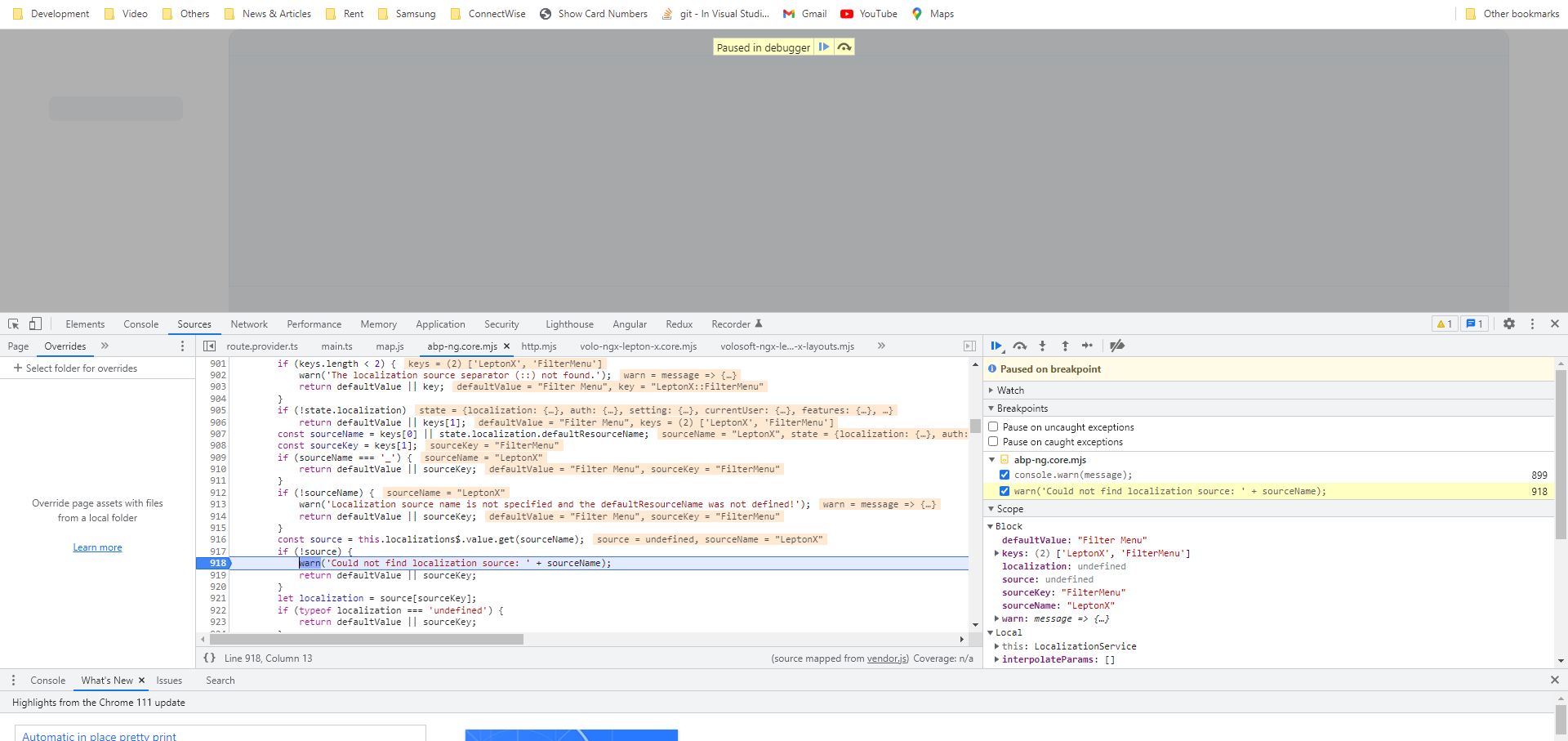
What i wonder is, how does the angular leptonx module is taking the resource from the backend? If you create a solution from scratch with angular, it doesn't include the leptonx module inside HttpApi.Host project
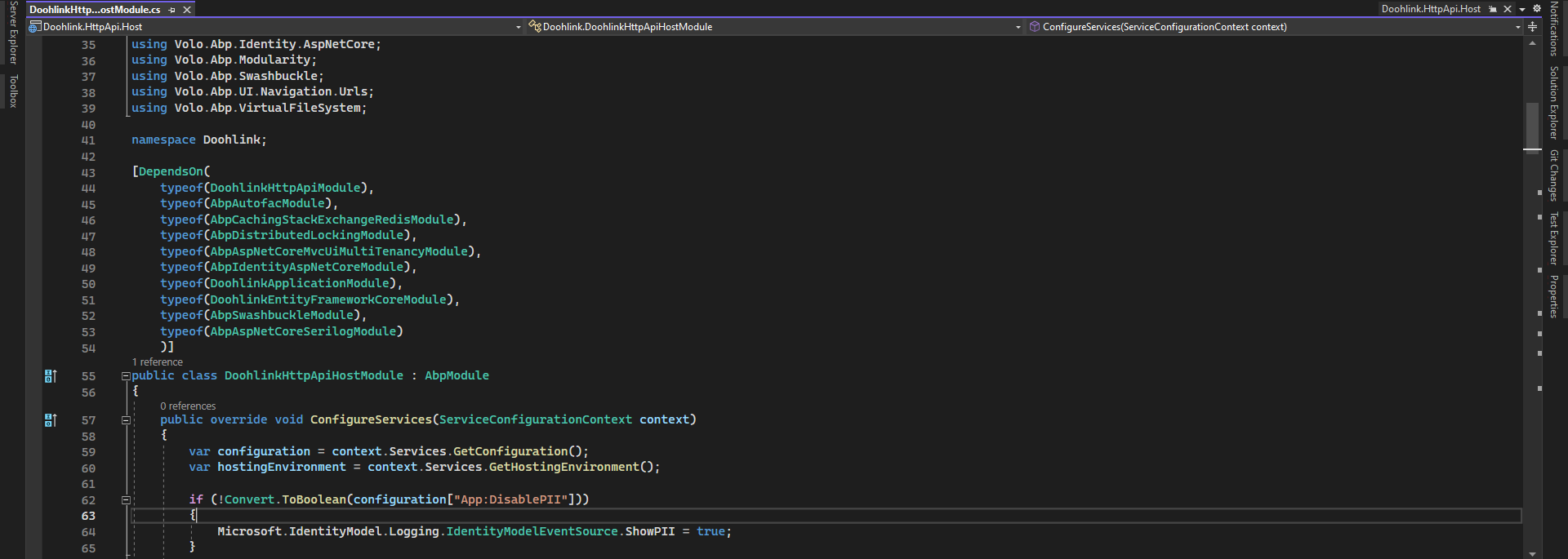
shouldn't it include the localization resource so it can find it inside resources for angular app?
- ABP Framework version: v7.0.3
- UI type: Angular
- DB provider: EF Core
- Tiered (MVC) or Identity Server Separated (Angular): yes
- Exception message and stack trace:
- Steps to reproduce the issue:"
Hello. I have 2 questions that i couldn't understand. I use abp cli 7.0.3
- I have created a brand new app from scratch with -t app-pro template with this cli command
abp new Doohlink -t app-pro -u angular -dbms PostgreSQL --separate-auth-server -m maui -csf
If i want to do npm install inside angular folder i got an error about peerdependency here is the short version of the error.
Could not resolve dependency: peer @ng-bootstrap/ng-bootstrap@"12.1.2" from @volosoft/abp.ng.theme.lepton-x@2.0.4 node_modules/@volosoft/abp.ng.theme.lepton-x @volosoft/abp.ng.theme.lepton-x@"^2.0.0-rc.2" from the root project
Conflicting peer dependency: @ng-bootstrap/ng-bootstrap@12.1.2 node_modules/@ng-bootstrap/ng-bootstrap peer @ng-bootstrap/ng-bootstrap@"12.1.2" from @volosoft/abp.ng.theme.lepton-x@2.0.4 node_modules/@volosoft/abp.ng.theme.lepton-x @volosoft/abp.ng.theme.lepton-x@"^2.0.0-rc.2" from the root project
Fix the upstream dependency conflict, or retry this command with --force or --legacy-peer-deps to accept an incorrect (and potentially broken) dependency resolution.
when i do yarn it executes and if i do yarn start everything works fine. What is the reason behind this should i use yarn all the time and why npm is having problems?
- if i want to add a module with abp add-module command then i can not build those projects with ng build command. here is the command that i use.
abp add-module Doohlink.CreativeManagement --new -t module-pro --add-to-solution-file --startup-project .\aspnet-core\src\Doohlink.HttpApi.Host\Doohlink.HttpApi.Host.csproj -s .\aspnet-core\Doohlink.sln
when i try to run
ng build creative-management
it gives me an error.
Error: Could not find the '@angular-devkit/build-ng-packagr:build' builder's node package.
"@angular-devkit/build-angular": "^15.0.1", is inside my dev dependencies. and i can see it inside node-modules folder.
is this a bug? or am i doing sth wrong over here? Thank you.

